I guess it’s the upcoming Cairo trip, but I’ve been in a very nostalgic mood recently. In preparation for another project that’s brewing in my head, I’ve also been thinking more carefully about how I learned to cook. I owe a lot of it to one book.
Back in February, when the nostalgia was first starting to swell, I was overcome with an urge to cook Indian food. Whenever anyone asks me what my specialty is, I shrug and say Indian, even though I haven’t cooked it in years, and I could tell you less than Wikipedia about the history, culture, roots, etc. of it. I’ve never been to India, and I have no ancestral connection to Southeast Asia whatsoever.
But in culinary-education terms, India is really where I started out.
I find it hard to believe that I haven’t bitched about my broke winter in London on this blog, but here’s the summary: 1994. Demoralizing job. Nasty boyfriend. Awful roommate. Chronically cold. Nescafe. Drunks galore. No money.
So, because we couldn’t actually afford to go out and see London, my boyfriend began cooking dinner (a single saving grace). He picked up a copy of Madhur Jaffrey’s Indian Cooking, and when we broke up, I got the book.
Actually, now that I’m telling this, I’m a little shaky on when that book entered the picture. London was a blur of bad weather and “bacon misshapes”from the cheapo bin at the butcher, but I’m pretty sure Madhur was already there, a steadying force that sensibly broke down a highly complex cuisine into the basics: Toast spices. Make ginger-garlic paste. Fry. Commence with particulars.
After London, I moved to Bloomington, Indiana, for grad school. Madhur got some stained pages that year–the ex had been extremely finicky about books, so I took satisfaction in breaking this one in. The next year, I moved into a huge house with three other people (far better boyfriend, exceptionally good roommates), and whole chapters were made greasy and sticky for posterity.
Sometime during that second year, when I got truly-o sick of medieval Arabic poetry, I started reading Cook’s Illustrated, which I still heartily recommend for anyone who wants to really understand why cooking works. But it wasn’t until I got an issue with a story about curries that I realized what a clash of civilizations I’d waded into.
Nearly every paragraph had some variation on “that’s not how I learned it in France”–pretty condescending by the third column. I could practically see the editors shaking their heads in wonder that this curry business worked at all, what with not browning the meat, and not thickening the sauce, and throwing spices in hot oil, and all that crazy business.
I guess knowing “French technique” is important. I owe them for my gravy-making skills, even if my dad never presented it to me in those terms, and the concept of white sauce (‘scuse me, bechamel). And boiling down wine is a good idea.
But my life was a lot happier, in a dippy “It’s a Small World After All” way, before I realized how the French barreled in and declared themselves the boss of food. The Italians managed to sneak in before the kitchen door swung back, but it’s still a ridiculously narrow selection when you consider just how many delicious things there are to eat all over the globe.
Years later, when I was considering going to cooking school, I had a hard time finding one that gave more than lip service to cuisines that didn’t rhyme with Wench and Vitalian. I wasn’t too excited about joining a cult that looked at Madhur Jaffrey and said, “Weird!” and not, “Wonderful!”
At one esteemed institute, I sat in on a class about risotto. The guy was explaining how you have to stir to release the starch. I piped up, “Cool! It’s exactly the opposite of a good pilaf, or a biryani, where you rinse all the starch off to start with, and make sure not to jostle the rice at all.” Crickets. Shuffling feet.
My fascination with Indian food started to fade away sometime in 2000. I’d gone freestyle–I could honestly say, “I’ll just pop into the kitchen and whip up a curry!” Not only had I met the challenge, but at that point the Madhur Jaffrey book, and everything I’d learned from it, was associated with two dead relationships. It was time to move on.
I’ve cooked a lot of other food since then, but nothing has given me quite the same thrill of discovery. That single Indian cookbook taught me not just no-fail Potatoes with Sesame Seeds (p. 114), but also how to look at every cuisine as a series of techniques: the same steps that every woman (probably) has been doing for centuries, usually while seated on a kitchen floor and slicing into her hand with a dull knife. The differences aren’t only in ingredients, but in how you slice your onions, whether you add meat stock or water, whether you cook something in a sauce or add the sauce after.
I also learned some skills that apply whatever you’re cooking: Measure the fiddly stuff before you turn on the heat (the French didn’t invent mise en place). And clean as you go, because crusty ginger-garlic paste is a bitch to get out of the blender.
When I opened up Indian Cooking again this February, it flopped obediently open to a grease-spot-dappled spread for The Lake Palace Hotel’s Aubergine (Eggplant) Cooked in the Pickling Style. Page 75, Lemony Chicken with Fresh Coriander, is distinctly yellow, thanks to a little turmeric fiasco. Cauliflower with Potatoes, which made an Indiana roommate named Wayne say, “Whoa, dude–it’s like cauliflower, but funky,” is marked with some mysterious crunchy bits.
The strongest proof of just how way-back these recipes go with me came when I was whizzing up my first batch of ginger-garlic paste for that February meal. Peter, who now seems like he’s always been around, looked in and said, “What the hell are you doing in that blender?”
Fortunately, he didn’t sound like a snooty French chef when he said it. And he loved the eggplant.
————-
Since the Magic Book is now out of print, I feel like I can in good conscience copy (loosely) a recipe here. It’s basically the same as what’s in the book, but frying eggplant is tedious and grease-consuming, so I now roast the eggplant in the oven instead.
LAKE PALACE EGGPLANT
adapted from Madhur Jaffrey’s Indian Cooking
Preheat oven to 400 degrees.
Slice up
1 large eggplant (approx. 1 3/4 lb.)
into wedges about 3/4-inch thick and lay on a cookie sheet; drizzle generously with vegetable oil. Roast eggplant in the oven, turning once, until the pieces are soft and lightly browned. Drizzle on a little more oil if they’re looking parched. When they’re done, take them out and set aside.
While the eggplant is roasting, throw in a blender or food processor:
1-inch cube of fresh ginger, peeled and chopped into a couple of pieces
6 cloves garlic, peeled (or more, but not tons more)
1/4 cup water
Whiz up till you have a smooth paste.
Also, measure out your spices. In one small cup, combine:
1 tsp whole fennel seeds (or a little more, if your spices are old and tired, or you just like fennel)
1/2 tsp kalonji (black onion seeds) or whole cumin seeds (kalonji is good, but don’t beat yourself up over it)
In a separate cup, combine:
1 tbsp ground coriander seeds
1/4 tsp ground turmeric
1/8 tsp cayenne pepper (more, if you like)
1 1/2 tsp salt
Put both bowls close to the stove.
In a heavy saucepan over medium flame, heat:
3 tbsp vegetable oil
When it’s shimmery, toss in the fennel and kalonji/cumin. After they’ve darkened slightly (just a few seconds), pour in:
3 medium tomatoes, peeled and chopped (canned ones work fine, but make it 4 in that case)
along with the ginger-garlic paste and the other cup of ground spices. There will be a bit of spattering. Let it all simmer, stirring a bit, until a lot of the liquid is cooked away, and the the whole thing looks pastelike–this takes 5 minutes or so, depending on how high you have the flame set.
Now put in the fried eggplant slices and mix gently. Cook on medium-low heat for about 5 minutes, stirring very gently. Cover the pan, turn heat to very low and cook another 5 or 10 minutes–this makes all the flavors meld.
Serve hot or cold. Serves 6, if you’re lucky.


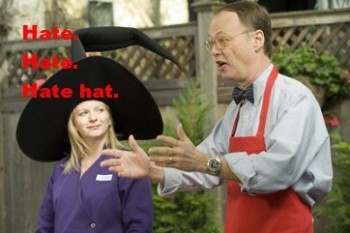
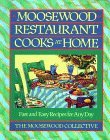 Fortunately, Livia had brought a very useful cookbook with her:
Fortunately, Livia had brought a very useful cookbook with her: 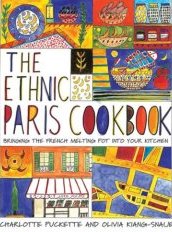
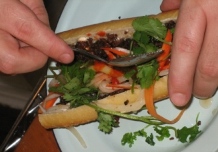 A banh mi is meant to be gulped down while standing on a sidewalk, hunkered against the wind on a park bench, or crouched on a rickety seat in front of a jewelry display counter (if you’re at Banh Mi Saigon). It’s easier to be outside, because then you don’t have to worry about the crumbs flying everywhere. (If you aren’t banh-mi-savvy yet, read up at
A banh mi is meant to be gulped down while standing on a sidewalk, hunkered against the wind on a park bench, or crouched on a rickety seat in front of a jewelry display counter (if you’re at Banh Mi Saigon). It’s easier to be outside, because then you don’t have to worry about the crumbs flying everywhere. (If you aren’t banh-mi-savvy yet, read up at 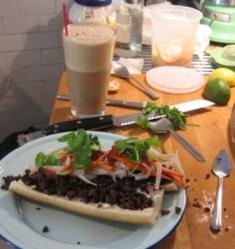 In retrospect, this caramel business didn’t seem so essential, because all Peter did was mix up the pork and the five-spice, pour on the caramel sauce and stick the thing in the broiler–then every few minutes, pull it out, stir out around, and let it recaramelize. He admitted to pouring on lots more sugar in the process. It took a while to get really tasty. And it really was not like Banh Mi Saigon’s. But it tasted great–more like a snack food than anything.
In retrospect, this caramel business didn’t seem so essential, because all Peter did was mix up the pork and the five-spice, pour on the caramel sauce and stick the thing in the broiler–then every few minutes, pull it out, stir out around, and let it recaramelize. He admitted to pouring on lots more sugar in the process. It took a while to get really tasty. And it really was not like Banh Mi Saigon’s. But it tasted great–more like a snack food than anything.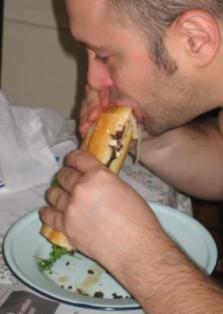 The daikon and carrot and cuke had been sitting in their little pickling juices for a bit, so he laid those on, then some cilantro sprigs and slices of green chili. (“Regular or spicy?” he called out from the kitchen, in an attempt to re-create the Saigon experience.)
The daikon and carrot and cuke had been sitting in their little pickling juices for a bit, so he laid those on, then some cilantro sprigs and slices of green chili. (“Regular or spicy?” he called out from the kitchen, in an attempt to re-create the Saigon experience.)